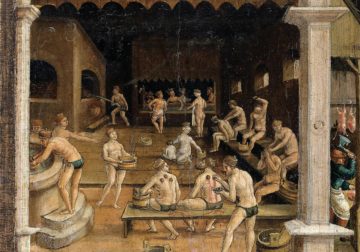Clare Watson in The Scientist:
 In medieval times, long before there were bathrooms in private homes, bathing was a social affair. Visitors to Dutch and German bathhouses in the late Middle Ages emerged from such spaces cleansed of more than just their grime: They also received basic medical care from “baders,” bathhouse proprietors who were also licensed health practitioners, skilled at lancing abscesses and pulling teeth. Steam rooms, mineral baths, cupping, and herbal concoctions were also commonly used to alleviate ailments from scabies and leprosy to migraines and miscarriages.
In medieval times, long before there were bathrooms in private homes, bathing was a social affair. Visitors to Dutch and German bathhouses in the late Middle Ages emerged from such spaces cleansed of more than just their grime: They also received basic medical care from “baders,” bathhouse proprietors who were also licensed health practitioners, skilled at lancing abscesses and pulling teeth. Steam rooms, mineral baths, cupping, and herbal concoctions were also commonly used to alleviate ailments from scabies and leprosy to migraines and miscarriages.
Not until Victorian times would bathhouses become a little noticed but influential item in public health policies. But according to Janna Coomans, a historian at Utrecht University in the Netherlands who studies public health in medieval cities, bathhouses provided access to more affordable medical care as baders charged less than doctors for their services. Sweating, bloodletting, and lancing were attempts to correct an imbalance in the four “humors”—phlegm, blood, yellow bile and black bile—that were thought to cause ill health. While these practices may seem unhygienic by modern standards, bathhouses enabled “a large part of the population to maintain health and hygienic norms, according to their ideas of health,” Coomans says.
More here.
